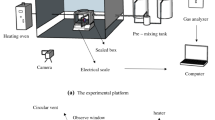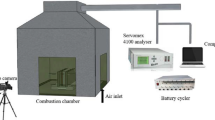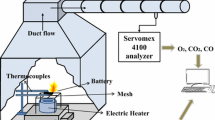Abstract
Thermal runaway (TR) considerably restricts the applications of lithium-ion batteries (LIBs) and the development of renewable energy sources, thus causing safety issues and economic losses. In the current study, the staged TR characteristics of three LIBs are examined using a self-built experimental platform and cone calorimeter. The results indicate that the TR of the ternary lithium and lithium cobalt batteries successively underwent the following stages: smoke production, swelling, bursting and combustion. By contrast, the lithium iron phosphate battery experiences smoulder instead of combustion during TR process. The TR time of the ternary lithium, lithium cobalt oxide and lithium iron phosphate batteries are 728 s, 689 s and 849 s, and the critical temperatures are 260.02 °C, 240.84 °C and 290.88 °C, respectively. Moreover, the lithium cobalt oxide battery has the largest heat release of 0.027 MJ m-2, the ternary lithium battery presents the most mass loss rate of 0.75 g s-1, and the lithium iron phosphate battery produced the largest smoke, CO and CO2 during the TR process. These results reveal the safety and stability of three LIBs and can be beneficial for studies on the proactive process safety and potential hazard prevention of LIBs.











Similar content being viewed by others
References
Netz B, Davidson OR, Bosch PR, Dave R, Meyer LA. Climate change 2007: contribution of working group III to the fourth assessment report of the intergovernmental panel on climate change. Comput Geom. 2007;18:95–123.
Lu LG, Han XB, Li JQ, Hua JF, Ouyang M. A review on the key issues for lithium-ion battery management in electric vehicles. J Power Sources. 2013;226:272–88.
Cao WJ, Lei B, Shi YJ, Dong T, Peng P, Zheng YD, et al. Ponderation over therecent safety accidents of lithium-ion battery energy storage stations in South Korea. Energy Storage Sci Technol. 2020;9:1539–47.
Wang Z, Yang H, Li Y, Wang G, Wang J. TR and fire behaviors of large-scale lithium ion batteries with different heating methods. J Hazard Mater. 2019;379:120730.
Wu TQ, Chen D, Wang QS, Sun JH. Comparison analysis on the TR of lithium-ion battery under two heating modes. J Hazard Mater. 2018;344:733–41.
Feng X, He XM, Ouyang M, Wang L, Lu L, Ren DS, et al. A coupled electrochemical-thermal failure model for predicting the TR behavior of lithium ion batteries. J Electrochem Soc. 2018;165:A3748–65.
Ren DS, Feng XN, Lu LG, Ouyang M, Zheng SQ, Li JQ, et al. An electrochemical-thermal coupled overcharge-to-thermal-runaway model for lithium ion battery. J Power Sources. 2017;364:328–40.
Feng XN, Lu LG, Ouyang MG, Li JQ, He XM. A 3D TR propagation model for a large format lithium ion battery module. Energy. 2016;115:194–208.
Noh HJ, Youn SJ, Yoon CS, Sun YK. Comparison of the structural and electrochemical properties of layered Li [NixCoyMnz]O2 (x = 1/3, 0.5, 0.6, 0.7, 0.8 and 0.85) cathode material for lithium-ion batteries. J Power Sources. 2013;233:121–30.
Wang QS, Ping P, Zhao XJ, Chu GQ, Sun JH, Chen CH. TR caused fire and explosion of lithium ion battery. J Power Sources. 2012;208:210–24.
Hossein M, Guoping D, Anaba A, Jason H. Thermal stability studies of Li-Ion cells and components. J Electrochem Soc. 1999;146(9):3224–9.
Liu X, Stoliarov SI, Denlinger M, Masias A, Snyder K. Comprehensive calorimetry of the thermally-induced failure of a lithium ion battery. J Power Sources. 2015;280:516–25.
Said AO, Lee C, Liu X, Wu ZB, Stoliarov SI. Simultaneous measurement of multiple thermal hazards associated with a failure of prismatic lithium ion battery. Proc Combust Inst. 2019;37:4173–80.
Balakrishnan P, Ramesh R, Kumar TP. Safety mechanisms in lithium-ion batteries. J Power Sources. 2006;155:401–3.
Roth EP, Doughty DH, Franklin J. DSC investigation of exothermic reactions occurring at elevated temperatures in lithium-ion anodes containing PVDF-based binders. J Power Sources. 2004;134(2):222–34.
Kvasha A, Gutiérrez C, Osa U, Meatza ID, Blazquez JA, Macicior H, et al. A comparative study of TR of commercial lithium ion cells. Energy. 2018;159:547–57.
Feng XN, Zheng SQ, Ren DS, He XM, Wang L, Liu X, et al. Key characteristics for TR of Li-ion batteries. Energy Procedia. 2019;158:4684–9.
Wang QS, Sun JH, Chen CH. Enhancing the thermal stability of LiCoO2 electrode by 4-isopropyl phenyl diphenyl phosphate in lithium ion batteries. J Power Sources. 2006;162:1363–6.
Jhu CY, Wang YW, Shu CM, Chang JC, Wu HC. Thermal explosion hazards on 18650 lithium ion batteries with a VSP2 adiabatic calorimeter. J Hazard Mater. 2011;192:99–107.
Said M, Tohir M. Characterization of TR behaviour of cylindrical lithium-ion battery using Accelerating Rate Calorimeter and oven heating. Case Stud Therm Eng. 2021;28:101474.
Jin CY, Sun YD, Wang HB, Lai X, Wang SH, Chen SQ, et al. Model and experiments to investigate TR characterisation of lithium-ion batteries induced by external heating method. J Power Sources. 2021;504:230065.
Ping P, Wang QS, Huang PF, Li K, Sun JH, Kong DP, et al. Study of the fire behavior of high-energy lithium-ion batteries with full-scale burning test. J Power Sources. 2015;285:80–9.
Zhang QS, Liu TT, Wang QS. Experimental study on the influence of different heating methods on TR of lithium-ion battery. J Energy Storage. 2021;42:103063.
Quintiere JG. More on methods to measure the energetics of lithium ion batteries in TR. Fire Saf J. 2021;124:103382.
Larsson F, Mellander BE. Abuse by external heating, overcharge and short circuiting of commercial lithium-ion battery Cells. J Electrochem Soc. 2014;161:A1611–7.
Golubkov AW, Fuchs D, Wagner J. Thermal-runaway experiments on consumer Li-ion batteries with metal-oxide and olivin-type cathodes. RSC Adv. 2013;4:3633–42.
Zhu YL, Wang CJ, Gao F, Shan MX, Zhao PL, Meng QF, et al. Rupture and combustion characteristics of lithium-ion battery under overcharge. J Energy Storage. 2021;38:661–70.
Fu YY, Lu S, Li KY, Liu CC, Cheng XD, Zhang HP. An experimental study on burning behaviors of 18650 lithium ion batteries using a CONE. J Power Sources. 2015;273:216–22.
Zhong GB, Mao BB, Wang C, Jiang L, Xu KQ, Sun JH, et al. TR and fire behavior investigation of lithium ion batteries using modified CONE. J Therm Anal Calorim. 2019;135:2879–89.
Yang Y, Wang ZR, Guo PK, Chen SC, Bian H, Tong X, et al. Carbon oxides emissions from lithium-ion batteries under TR from measurements and predictive model. J Energy Storage. 2021;33:101863.
Huang PF, Yao CX, Mao BB, Wang QS, Sun JH, Bai ZH. The critical characteristics and transition process of lithium-ion battery TR. Energy. 2020;213:119082.
Röder P, Baba N, Wiemhöfer HD. A detailed thermal study of a Li[Ni0.33Co0.33Mn0.33]O2/LiMn2O4-based lithium ion cell by accelerating rate and differential scanning calorimetry. J Power Sources. 2014;248:978–87.
Miao Y, Hynan P, von Jouanne A, Yokochi A. Current Li-ion battery technologies in electric vehicles and opportunities for advancements. Energies. 2019;12:1074–94.
Zhang WJ. Structure and performance of LiFePO4 cathode materials: a review. J Power Sources. 2011;196:2962–70.
Wang YD, Jiang JW, Dahn JR. The reactivity of delithiated Li(Ni1/3Co1/3Mn1/3)O2, Li(Ni0.8Co0.15Al0.05)O2 or LiCoO2 with non-aqueous electrolyte. Electrochem Commun. 2007;9:2534–40.
Xu B, Qian D, Wang Z, Meng YS. Recent progress in cathode materials research for advanced lithium ion batteries. Mater Sci Eng R Rep. 2012;73(5–6):51–65.
Zhao YJ, Li J, Dahn JR. Interdiffusion of cations from metal oxide surface coatings into LiCoO2 during sintering. Chem Mater. 2017;29(12):5239–48.
Huang ZH, Li H, Mei W, Zhao C, Sun J, Wang QS. TR behavior of lithium iron phosphate battery during penetration. Fire Technol. 2020;56(6):2405–26.
Huang ZH, Yu Y, Duan Q, Qin P, Sun J, Wang QS. Heating position effect on internal TR propagation in large-format lithium iron phosphate battery. Appl Energy. 2022;325:119778.
Chen GY, Richardson TJ. Thermal instability of Olivine-type LiMnPO4 cathodes. J Power Sources. 2010;195(4):1221–4.
Said AO, Lee C, Stoliarov SI. Experimental investigation of cascading failure in 18650 lithium ion cell arrays: impact of cathode chemistry. J Power Sources. 2020;446:227347.
Bugryniec PJ, Davidson JN, Cumming DJ, Brown SF. Pursuing safer batteries: thermal abuse of LiFePO4 cells. J Power Sources. 2019;414:557–68.
Golubkov AW, Scheikl S, Planteu R, Voitic G, Wiltsche H, Stangl C, et al. TR of commercial 18650 Li-ion batteries with LFP and NCA cathodes–impact of state of charge and overcharge. RSC Adv. 2015;5(70):57171–86.
Larsson F, Bertilsson S, Furlani M, Albinsson I, Mellander BE. Gas explosions and TRs during external heating abuse of commercial lithium-ion graphite-LiCoO2 cells at different levels of ageing. J Power Sources. 2018;373:220–31.
Aurbach D, Zaban A, Ein-Eli Y, Weissman O, Chusid I, Markovsky B, et al. Recent studies on the correlation between surface chemistry, morphology, three-dimensional structures and performance of Li and Li-C intercalation anodes in several important electrolyte systems. J Power Sources. 1997;68(1):91–8.
Spotnitz R, Franklin J. Abuse behavior of high-power, lithium-ion cells. J power sources. 2003;113(1):81–100.
Acknowledgements
The research was supported by De Montfort University through its distinguished Vice-Chancellor 2020 Programme and by the UK Science and Technology Facilities Council (STFC) through the Batteries Early Career Researcher Award.
Author information
Authors and Affiliations
Contributions
YX was involved in conceptualisation, resources and formal analysis. JRZ was responsible for data curation, methodology and writing—original draft. LY contributed to investigation and visualization. BL assisted with validation. YT helped with resources and writing—review and editing.
Corresponding author
Ethics declarations
Conflict of interest
The authors declare no known competing financial interests or personal relationships that could have appeared to influence the work reported in this paper.
Additional information
Publisher's Note
Springer Nature remains neutral with regard to jurisdictional claims in published maps and institutional affiliations.
Rights and permissions
Springer Nature or its licensor (e.g. a society or other partner) holds exclusive rights to this article under a publishing agreement with the author(s) or other rightsholder(s); author self-archiving of the accepted manuscript version of this article is solely governed by the terms of such publishing agreement and applicable law.
About this article
Cite this article
Xiao, Y., Zhao, JR., Yin, L. et al. Staged thermal runaway behaviours of three typical lithium-ion batteries for hazard prevention. J Therm Anal Calorim (2024). https://doi.org/10.1007/s10973-024-13080-0
Received:
Accepted:
Published:
DOI: https://doi.org/10.1007/s10973-024-13080-0




